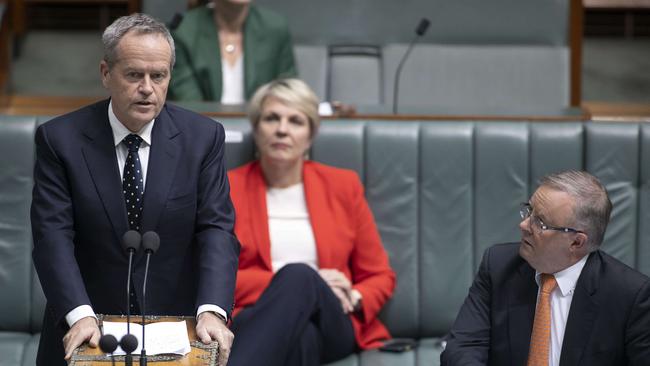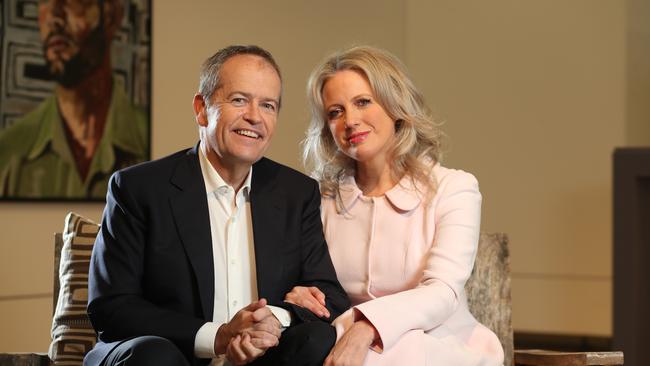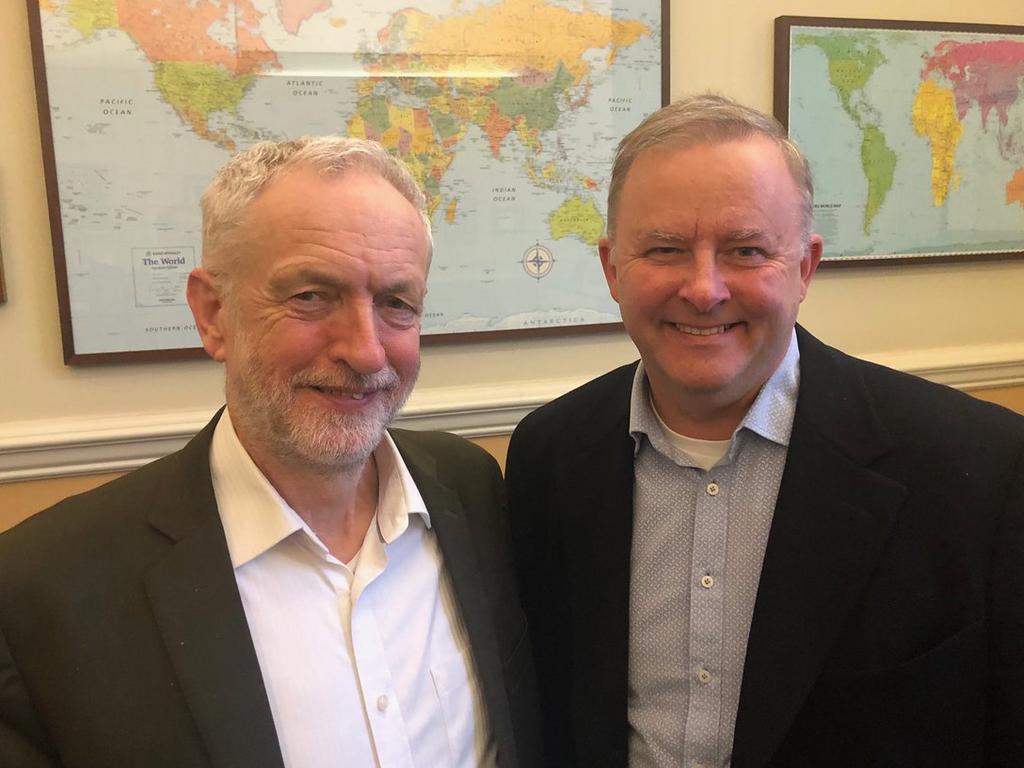Bill Shorten the comeback wannabe
After Bill Shorten lost the ‘unlosable election’, Labor hardheads were determined not to repeat the mistakes. It seems one man still doesn’t get it.

Inside Labor, this was a catastrophe. Confidence had run so high close to election day that defeat was almost inconceivable. Opinion polls indicated voters were disenchanted with the Coalition’s internal bickering and prime ministerial implosions during two terms in office. Commentators and election bets predicted a Shorten-Labor win. It didn’t happen.
Two years on, still grappling with the defeat, Labor hardheads say they are determined not to repeat the mistakes, but it would seem one man still doesn’t understand what happened. Not entirely, anyway.
Shorten apparently thinks he can make a comeback.
According to numerous accounts provided to Inquirer from senior Labor colleagues in Shorten’s political orbit, he believes he can become Labor leader again one day and then realise his long-held dream to be prime minister.
A fantasy? Not for Shorten. He has told many he wants to lead again, even if some allies have tried to tamp down the comeback hopes.
“He’s floated the idea a number of times,” one told Inquirer. “And everyone says, ‘No Bill, after two terms, and two losses, it’s over.’ ”
Shorten seems to dismiss what he doesn’t want to hear. “He’s still got the baton in the knapsack,” says a Victorian Labor figure with links to Shorten’s political intimates. “Bill’s always said, ‘I’m going to be the Labor prime minister one day,’ and he feels no need to stop saying that because he’s lost twice.”
A day after the 2019 election debacle, Shorten asked a senior colleague: “Do you think I can come back from this?” When a Nine newspaper article reported a few days later that Shorten had told allies he wanted to regain the party leadership, a Shorten spokesman dismissed the story as “bullshit”.

Shorten did stand down. Ever since, however, he has kept a watchful eye on the fortunes of NSW rival Anthony Albanese, elected unopposed as his successor. Albanese is believed to view Shorten with suspicion, and Shorten’s profile is again on the rise. As a former leader he has standing to speak out on issues, and he remains opposition spokesman on the National Disability Insurance Scheme and government services.
In the past week he has overshadowed Albanese with his comment on the ABC’s Afternoon Briefing program that Scott Morrison’s vaccine rollout is a “shitshow”. This was followed up during his regular slot on Nine’s Today show. On Thursday he appeared the ABC’s Q&A. He pops up on Sky News.
When thinking aloud among his Victorian party mates, as they tell Inquirer, Shorten has cited Joe Biden assuming office as US President at 78 to back his case for playing the long game in politics.
As one Labor source says: “He’s told people Biden is proof it’s never too late, he wants to be leader again, and therefore you better keep treating him seriously.”
Another example Shorten has allegedly raised to justify a leadership re-run, oddly enough, is John Howard. Howard’s personal approval rating as Liberal opposition leader in the late 1980s was woeful. But after losing the 1987 election and the leadership, Howard returned to defeat Paul Keating in 1996 and serve as prime minister for 11 years.
In more recent times, Shorten has been explicit with some senior colleagues: “I’m two leaders off coming back.” What does this mean? On Shorten’s part, it’s shorthand for grand assumptions – and a grand scenario.
It assumes Albanese, struggling in personal opinion polls, smothered by Morrison’s dominant message during the pandemic, and shunned by voters wanting continuity in a crisis, will lead Labor to another defeat at next year’s election. With Albanese regarded by his party as a one-term opposition leader, the next cab off the rank in the event of defeat almost certainly would be Tanya Plibersek, Labor’s most popular figure.
Enter Shorten, in a scenario that continues this way: after working well with the affable Plibersek over time, Shorten proffers himself as her deputy. As Plibersek comes from the NSW Labor Left, Shorten would argue he provides balance as an ALP right-winger from Victoria.
Under this “two leaders off” scenario, if Albanese is the first leader, then Plibersek is the second. According to those familiar with it, the mooted scenario can play out in two ways: Shorten takes over again as opposition leader during Plibersek’s first term if she does not work out; or he makes his move to reclaim the leadership after Plibersek supposedly loses to Morrison or Josh Frydenberg at the 2025 election.
If Shorten stayed in parliament until 2025, and the Coalition won a remarkable fifth term, he would be 58. At the 2028 election, Shorten would be 61. By then, supposedly, the Coalition would have run out of puff for a sixth term with voters open to a change of government. Shorten as the rehabilitated leader would pitch up a modest policy platform, unlike 2019, and take Labor to victory.
Shorten has always had an unshakeable sense of destiny that he would be prime minister, and Bob Hawke appears to have been his model. An extended conversation with Shorten in earlier days would often lead to him putting the question: “I think I could lead this country, what do you think?”
This was the dream that started at Melbourne’s Xavier College and Monash University, expanded when Shorten was a Young Labor operative, and turned into a well-funded campaign machine when he led the Australian Workers Union before entering parliament in 2007.
Inquirer asked Shorten if he saw the possibility of returning to the Labor leadership one day, whether he recalled telling others about his comeback ambitions, and what motivated him to recontest his seat at next year’s election when most former leaders move on. His spokeswoman said Shorten had “hung up his leadership running shoes” and “did not believe you have to be the leader to be a leader”. She said he “still has fire in the belly for Labor politics and the Aussie fair go” and wanted a “competent prime minister back in the Lodge”.
The difficulty with Shorten comparisons involving Hawke, Howard or Biden, and any imagined scenarios, are the giant flaws.
Hawke pursued his quest to become Labor prime minister with a ruthless personal determination. But if Hawke was in large part the model for Shorten, he did not attain his idol’s status as a high-achieving national figure before entering parliament. He had a brief stint of fame as a television commentator during the Beaconsfield mine disaster in 2006.
Shorten never attained Hawke’s remarkable ability to communicate directly with people at large, the source of his enduring popularity. Hawke took that with him to parliament and was prime minister in three years.

Shorten did not make it after helping to tear down Kevin Rudd and Julia Gillard as prime ministers, and then two goes as opposition leader. He scored a second term in 2016 because Labor came close to winning after a sluggish campaign by Malcolm Turnbull.
No opposition leader since Arthur Calwell in the ’60s has gone to three elections in the role, and Labor will not tolerate a leader who fails twice in a row any more.
Shorten allegedly still cannot fathom why voters did not warm to him. One from his circle claims Shorten is expert at winning ballots for others but loses perspective with himself.
“That’s why he’s not in the Lodge right now,” he says. “He can’t come to terms with the idea that he can’t get 100 per cent of Australians to love him. He needs to be loved, so personally it is very difficult for him. He’s great at talking to the party rank-and-file and unions, but it hasn’t translated to the wider community.”
Another asks why, if Shorten was so ambitious, did he not master presentational skills earlier on, including how to appeal to a political base beyond core Labor.
A more sympathetic voice from Shorten’s flock says it has required a huge turnaround in his identity to accept he is no longer party kingpin and no longer commands the numbers he once did: “The 2019 election result was difficult for all of us, but Bill had a lot to cope with. We wanted Bill to win because we wanted to win, we wanted to be in government.”
Some of Shorten’s colleagues say he never really stood for much. In 2015, when Melbourne ABC radio host Jon Faine asked him, “What does Bill Shorten actually believe in?”, Shorten replied, “Everybody is somebody.” Labor insiders and others were dismayed at this trite response from someone meant to have a vision for leading his country.
Shorten was the darling of the Melbourne business establishment back in 2006, its favourite union leader. He’d called for lower corporate tax rates. He was close to billionaire Richard Pratt and flew on his corporate jet. He was the CFMEU’s bitter enemy.
By 2017, Shorten was a political ally of Victoria’s militant CFMEU leader John Setka because that relationship was necessary to Shorten keeping factional control in the state ALP. Meanwhile, he berated “corporate leviathans” for their “lies” and “greed”. Which was the real Bill?
Shorten still has considerable political baggage unhelpful to the ALP. Among it, there are still questions about whether he gave hundreds of thousands of dollars of workers’ money as AWU leader to the activist group GetUp and ALP candidates – without authorisation. His union also has been fined for vastly pumping up its numbers, although former Shorten deputy Cesar Melhem was found responsible.
As for comparisons with Howard, they do not hold water. Howard lost one election, not two. He’d been Malcolm Fraser’s treasurer. He assumed the leadership again when his party needed him back because no one else was up to the task of matching Keating after John Hewson and Alexander Downer were deposed.
Shorten party colleagues debunk the suggestion that any comparison with Biden makes sense in the Australian context. They point out that the US party system is much more fluid and Australia has a party-based parliamentary system for choosing its national leader, not a publicly elected president. Meanwhile, members of congress have their own state-based brand loyalties and can last into their dotage, unusual in Australia’s party democracy.
A former Gillard government minister says: “Shorten can’t conceivably come back, with the same monotone and saying the same unremarkable things. If the Labor Party can’t find someone else in a generational shift, then it should give up the game.”
Inside federal Labor there is a generation of MPs still on the rise – Plibersek, Jim Chalmers, Richard Marles and Chris Bowen – who would not accept a Shorten comeback because he had his chance.
Those who know of Shorten’s comeback hopes say his support base has dwindled. He commands just a portion of the Victorian ALP he once led. The dominant group seems to be controlled by Marles and ex-senator Stephen Conroy, with about four to five votes in the party room still loyal to Shorten.
Shorten’s most fervent backers are Victorian senator Kimberley Kitching and her husband Andrew Landeryou. There’s also support from a few Victorian unions – the largest section of the Health Services Union, the Plumbers Union and the AWU. Shorten’s wife, Chloe, is said to be part of an ambition unit.
Almost certainly, Shorten could not secure support from Labor’s NSW Right again unless there was no one else. It would back Bowen before Shorten and could give its numbers to Plibersek as a potential election winner.
But this is assuming a federal Labor loss next year when the numbers are currently competitive for Labor at 53-47, ahead of the Coalition, according to Newspoll.
If Albanese did lose, Plibersek would easily win the ALP’s 50 per cent membership vote in a subsequent leadership ballot. She could win the other 50 per cent party room vote, depending on whether the Left fell behind her overall.
Chalmers is not believed to be in contention if Plibersek is in the race, but he could run for deputy. Marles is a “dark horse” for leader in the longer term, according to some Labor number crunchers.
Senior Labor figures claim Plibersek is wary of Shorten, despite their perceived closeness.
“Does he want to burn up some of the candidates that might be a threat to him after the next election?” says one. “Tanya is not stupid, she is very alive to what he’s up to.”
Where does this leave Shorten? Not as a future leader or deputy, it seems. The recurrent sentiment is: “We can’t go back to him.”
One plan B floated among some in Shorten’s circle is that – if he accepted his Everest was out of reach – a future Labor PM might offer him the coveted job as US ambassador in Washington. “He’d probably do a good job, but no one owes him that either,” says a Shorten insider.







When Bill Shorten lost the “unlosable election” in 2019 after two terms as Labor’s federal opposition leader, he and his party colleagues were devastated.